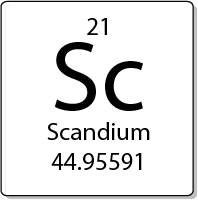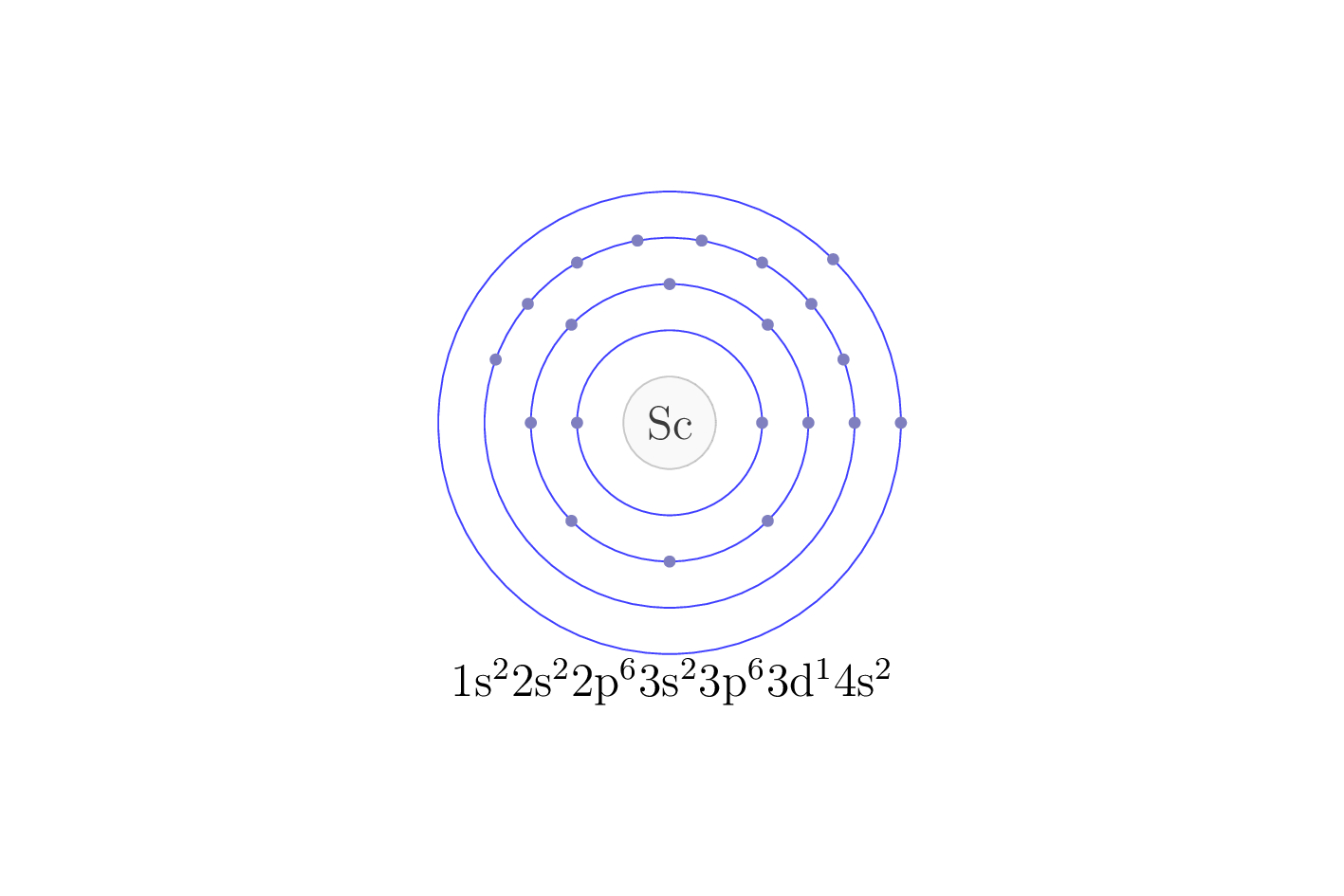
Scandium is a chemical element with the symbol Sc and atomic number 21. It is a silvery-white, rare earth metal that belongs to the transition metals group in the periodic table.
Scandium emits no lines in the visible region of the electromagnetic spectrum. Nevertheless, scandium can be detected by its lines in other regions of the spectrum. Until the beginning of the 20th century, scandium was thought to be one of the rarest elements on Earth. In 1908, however, the British chemist Sir William Crookes (1832–1919) discovered that scandium actually is widely distributed on Earth. Scandium is often recovered from uranium tailings.
Scandium is a soft, light metal similar to aluminum. It is so rare on Earth that it is very difficult to obtain large quantities of this element, however, it is also present in the sun and other stars. Scandium is only used for very specialized applications. The main ores in which it is found are gadolinite and euxenite, and thortveitite which also contain small amounts of many other rare metals, such as cerium and yttrium. It is extracted through a process called solvent extraction.
Scandium mixed with aluminum produces a very strong alloy, used in lightweight sports equipment such as lacrosse. It is also used in the manufacture of high-speed turbines in fighter aircraft.
Chemical properties
Scandium has a density of 3.0 g/cm3, it is a soft metal, and a silver colored.
Although scandium has no known biological function, however, very small (trace) amounts can be measured in parts per billion (ppb) concentrations in human blood and tissues.
Scandium is a fairly reactive element. It dissolves in water and most acids to form the Sc3+ ion. It reacts with atmospheric oxygen at normal temperatures. In nature, scandium readily forms an insoluble hydroxide (Sc(OH)3). In the laboratory, a hydride of formula ScH2 can be obtained, suggesting that the scandium ion is only Sc2+. Why the scandium hydride is not “+3” instead of “+2” is unknown. The scandium ion (Sc3+) forms compounds with the most common monovalent anions (ions with charges of “-1”). Thus, Sc(NO3)3 is easily formed, and with the halogens: ScF3, ScCl3, ScBr3 and ScI3. All these compounds are white and soluble in water.

Electron configuration
The electron configuration of an element describes the arrangement of electrons in the atoms of that element, and be used to predict its chemical properties and reactivity.
In the electron configuration notation, the letters "s", "p", "d", and "f" represent the different types of atomic orbitals, and the superscripts indicate the number of electrons in each orbital. The orbitals are filled in a specific order, starting with the lowest energy orbital and working up.

Emission spectra
Each element in the periodic table presents its own unique emission spectra, which is determined by the energy levels of its electrons. When an electron in an atom is excited to a higher energy level, it can de-excite by emitting a photon of light with an energy equal to the difference between the two levels. This results in a characteristic emission line in the spectra (which corresponds to specific wavelengths of light). These spectra are usefull to identify the elements present in a sample.

Symmary of properties (Sc)
| Atomic weight | 44.955908(5) |
| Discoverer (year) | Nilson, Lars Fredrik (1879) |
| Natural form | metallic solid (hexagonal) |
| Electron configuration | [Ar] 3d1 4s2 |
| M.p. (ºC) | 1539 |
| B.p. (ºC) | 2832 |
| Earth's crust abundance (ppm) | 22 |
| Isotope (abundance %) | 45Sc (100) |
| Density (g/cm3) | 3.00 |
| vdW radius (pm) | 215 |
| Covalent radius (pm) | 159 |
| Electronegativity (Pauling) | 1.54 |
| Vaporisation enthalpy (Kj/mol) | 305.00 |
| Fusion enthalpy (kJ/mol) | 14.10 |
| Specific heat capacity (J/g·K) at 25ºC and 1 at | 0.57 |
| Thermal conductivity (W/cm·K) at 25 ºC and 1 at | 0.160 |
| Oxidation number | 3 |
| Electronic affinity (eV) | 0.19 |
| 1st Ionization energy (eV) | 6.5615 |
Definition of terms in the previous table
- Atomic weight: The average mass of an element's atoms, typically given in atomic mass units (amu).
- Natural form: The most stable and abundant form of an element that occurs naturally in the environment.
- Electron configuration: The arrangement of electrons in an atom or molecule.
- Melting point: The temperature at which a solid substance turns into a liquid.
- Boiling point: The temperature at which a liquid substance turns into a gas.
- Earth's crust abundance (ppm): The concentration of an element in the Earth's crust, typically given in parts per million (ppm).
- Isotope (abundance %): A variant of an element that has the same number of protons in the nucleus, but a different number of neutrons. The abundance of an isotope is the percentage of the isotope in a sample of the element.
- Density (g/cm3): The mass of a substance per unit volume.
- vdW radius (pm): The radius of an atom or molecule as predicted by the van der Waals model, typically given in picometers (pm).
- Covalent radius (pm): The distance from the center of an atom to the center of another atom with which it is bonded covalently, typically given in picometers (pm).
- Electronegativity (Pauling): A measure of an atom's ability to attract electrons in a chemical bond, based on the Pauling scale.
- Vaporisation enthalpy (kJ/mol): The amount of energy required to convert a substance from a liquid to a gas at a constant temperature.
- Fusion enthalpy (kJ/mol): The amount of energy required to convert a substance from a solid to a liquid at a constant temperature.
- Specific heat capacity (J/g·K) at 25ºC and 1 at: The amount of heat required to raise the temperature of 1 gram of a substance by 1 degree Celsius at a constant pressure.
- Thermal conductivity (W/cm·K) at 25 ºC and 1 at: The ability of a substance to conduct heat, typically given in watts per centimeter per kelvin.
- Oxidation number: A positive or negative integer that represents the number of electrons that an atom has gained or lost in a chemical compound.
- Electronic affinity: The energy change associated with adding an electron to a neutral atom to form a negative ion.
- 1st Ionization energy: The energy required to remove the most loosely bound electron from a neutral atom.